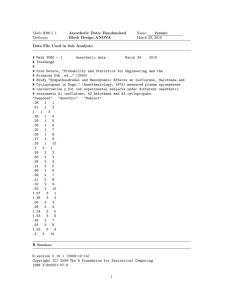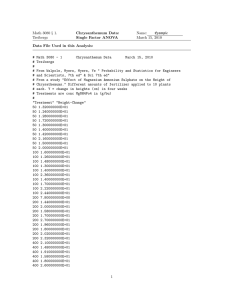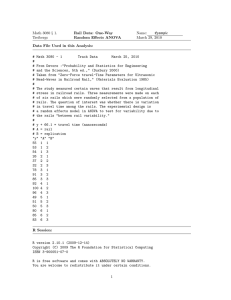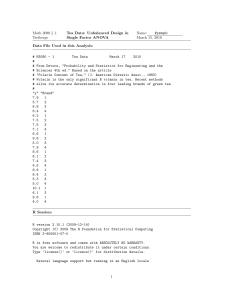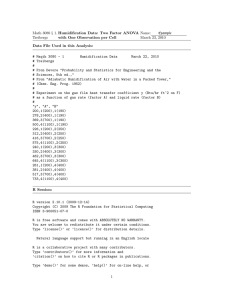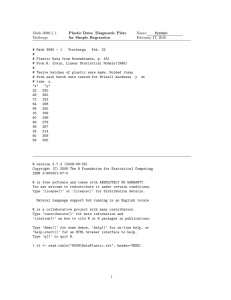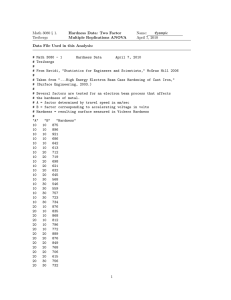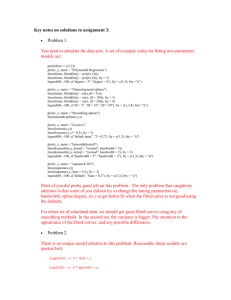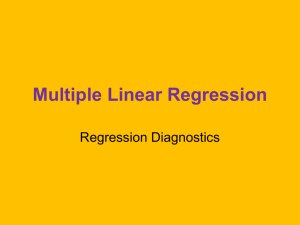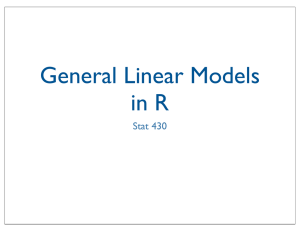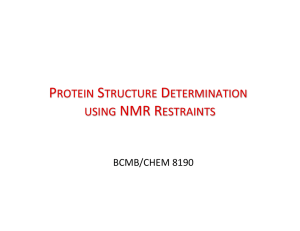Math 3080 § 1. Precambrian Iron Data: Tukey’s Honest Name: Example
advertisement
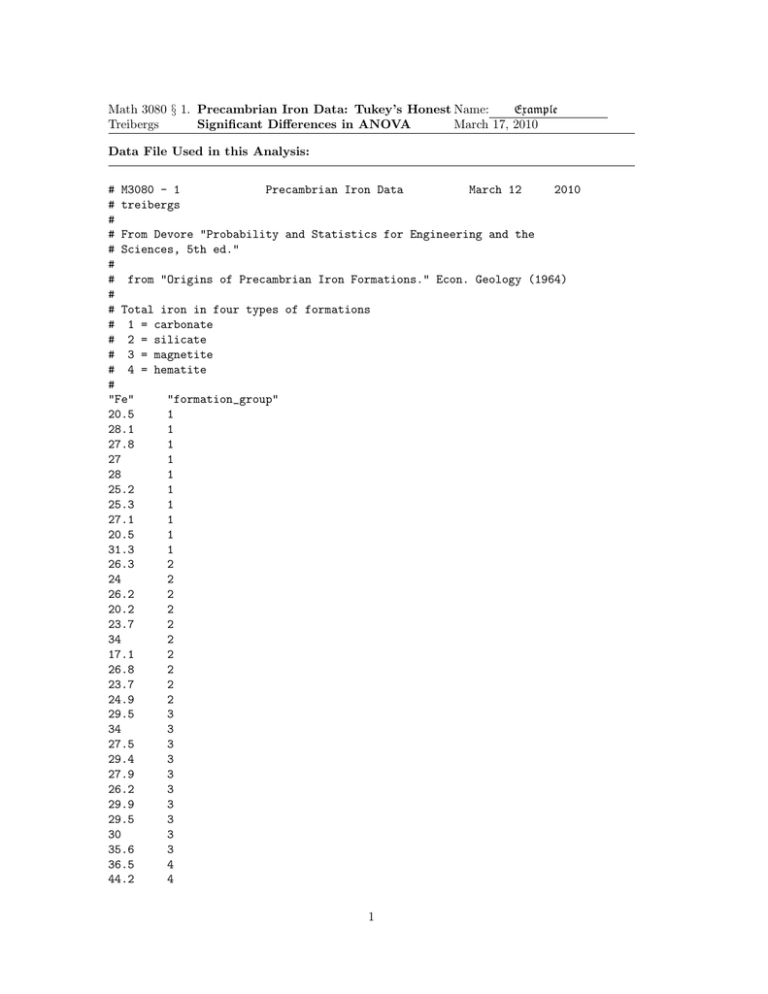
Math 3080 § 1. Precambrian Iron Data: Tukey’s Honest Name: Example Treibergs Significant Differences in ANOVA March 17, 2010 Data File Used in this Analysis: # M3080 - 1 Precambrian Iron Data March 12 2010 # treibergs # # From Devore "Probability and Statistics for Engineering and the # Sciences, 5th ed." # # from "Origins of Precambrian Iron Formations." Econ. Geology (1964) # # Total iron in four types of formations # 1 = carbonate # 2 = silicate # 3 = magnetite # 4 = hematite # "Fe" "formation_group" 20.5 1 28.1 1 27.8 1 27 1 28 1 25.2 1 25.3 1 27.1 1 20.5 1 31.3 1 26.3 2 24 2 26.2 2 20.2 2 23.7 2 34 2 17.1 2 26.8 2 23.7 2 24.9 2 29.5 3 34 3 27.5 3 29.4 3 27.9 3 26.2 3 29.9 3 29.5 3 30 3 35.6 3 36.5 4 44.2 4 1 34.1 30.3 31.4 33.1 34.1 32.9 36.3 25.5 4 4 4 4 4 4 4 4 R Session: R version 2.10.1 (2009-12-14) Copyright (C) 2009 The R Foundation for Statistical Computing ISBN 3-900051-07-0 R is free software and comes with ABSOLUTELY NO WARRANTY. You are welcome to redistribute it under certain conditions. Type ’license()’ or ’licence()’ for distribution details. Natural language support but running in an English locale R is a collaborative project with many contributors. Type ’contributors()’ for more information and ’citation()’ on how to cite R or R packages in publications. Type ’demo()’ for some demos, ’help()’ for on-line help, or ’help.start()’ for an HTML browser interface to help. Type ’q()’ to quit R. [R.app GUI 1.31 (5538) powerpc-apple-darwin8.11.1] [Workspace restored from /Users/andrejstreibergs/.RData] > tt <- read.table("M3081DataPrecambrian.txt", header=TRUE); tt Fe formation_group 1 20.5 1 2 28.1 1 3 27.8 1 4 27.0 1 5 28.0 1 6 25.2 1 7 25.3 1 8 27.1 1 9 20.5 1 10 31.3 1 11 26.3 2 12 24.0 2 13 26.2 2 14 20.2 2 15 23.7 2 16 34.0 2 2 17 17.1 2 18 26.8 2 19 23.7 2 20 24.9 2 21 29.5 3 22 34.0 3 23 27.5 3 24 29.4 3 25 27.9 3 26 26.2 3 27 29.9 3 28 29.5 3 29 30.0 3 30 35.6 3 31 36.5 4 32 44.2 4 33 34.1 4 34 30.3 4 35 31.4 4 36 33.1 4 37 34.1 4 38 32.9 4 39 36.3 4 40 25.5 4 > attach(tt) > formation <- factor(formation_group) >#==============================SUMMARY STATS BY FACTOR========== > tapply(Fe,formation,summary) $‘1‘ Min. 1st Qu. 20.50 25.22 Median 27.05 Mean 3rd Qu. 26.08 27.95 Max. 31.30 $‘2‘ Min. 1st Qu. 17.10 23.70 Median 24.45 Mean 3rd Qu. 24.69 26.28 Max. 34.00 $‘3‘ Min. 1st Qu. 26.20 28.28 Median 29.50 Mean 3rd Qu. 29.95 29.98 Max. 35.60 $‘4‘ Min. 1st Qu. 25.50 31.78 Median 33.60 Mean 3rd Qu. 33.84 35.75 Max. 44.20 3 >#==================RUN ANOVA=================================== > f1 <- aov(Fe Df formation 3 Residuals 36 --Signif. codes: ~ formation);summary(f1) Sum Sq Mean Sq F value Pr(>F) 509.12 169.707 10.849 3.199e-05 *** 563.13 15.643 0 *** 0.001 ** 0.01 * 0.05 . 0.1 1 > print(f1) Call: aov(formula = Fe ~ formation) Terms: Sum of Squares Deg. of Freedom formation Residuals 509.122 563.134 3 36 Residual standard error: 3.955074 Estimated effects may be unbalanced >#==============================PRINT MEANS AND EFFECTS========= > model.tables(f1,"means") Tables of means Grand mean 28.64 formation formation 1 2 3 4 26.08 24.69 29.95 33.84 > model.tables(f1,"effects",se=TRUE) Tables of effects formation formation 1 2 -2.56 -3.95 3 1.31 4 5.20 Standard errors of effects formation 1.251 replic. 10 4 >#=============================DRAW DIAGNOSTIC PLOTS=================== 20 30 26 28 fitted(f1) 30 25 Fe 35 32 40 34 45 > layout(matrix(1:4,ncol=2)) > plot(rstudent(f1),fitted(f1), ylab="Student. Resid.",ylim=max(abs(rstudent(f1)))*c(-11)); > plot(rstudent(f1)~fitted(f1),ylab="Student. Resid.", ylim=max(abs(rstudent(f1)))*c(-1,1));abline(h=c(0,-2,2),lty=c(2,3,3)) > plot(fitted(f1)~Fe);abline(0,1,lty=3) > qqnorm(rstudent(f1),ylab="Student. Resid.");abline(0,1,lty=4) > layout(1) 1 2 3 4 20 25 formation 30 35 40 45 Fe 2 1 0 -1 Student. Resid. 1 0 -1 -2 -2 -3 Student. Resid. 2 3 3 Normal Q-Q Plot 26 28 30 32 34 fitted(f1) -2 -1 0 1 Theoretical Quantiles 5 2 >#==================TUKEY’S HONEST SIGNIFICANT DIFFERENCES=============== > TukeyHSD(f1,ordered=TRUE) Tukey multiple comparisons of means 95% family-wise confidence level factor levels have been ordered Fit: aov(formula = Fe ~ formation) $formation diff lwr upr p adj 1-2 1.39 -3.3736803 6.15368 0.8603728 3-2 5.26 0.4963197 10.02368 0.0256750 4-2 9.15 4.3863197 13.91368 0.0000507 3-1 3.87 -0.8936803 8.63368 0.1459622 4-1 7.76 2.9963197 12.52368 0.0005352 4-3 3.89 -0.8736803 8.65368 0.1427984 >#=============DRAW SIMULTANEOUS CI BARS FOR MEANS DIFFERENCES=== > plot(TukeyHSD(f1,ordered=TRUE)) > abline(v=0,lty=5) >#==============FIND TUKEY HSD AND CI’S "BY HAND"============= > qT <- qtukey(.95,4,36);qT [1] 3.808798 > seHSD <- 3.955074*qT/sqrt(10);seHSD [1] 4.76368 > means <- tapply(Fe,formation,mean) > sort(means) 2 1 3 4 24.69 26.08 29.95 33.84 > c(means[1]-means[2]-seHSD,means[1]-means[2]+seHSD) 1 1 -3.37368 6.15368 > c(means[3]-means[2]-seHSD,means[3]-means[2]+seHSD) 3 3 0.4963198 10.0236802 > c(means[4]-means[2]-seHSD,means[4]-means[2]+seHSD) 4 4 4.38632 13.91368 > 6 4-3 4-1 3-1 4-2 3-2 1-2 95% family-wise confidence level 0 5 10 Differences in mean levels of formation 7
